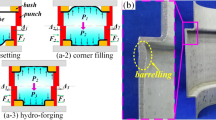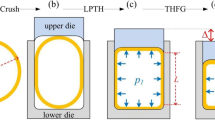Abstract
To solve the drawbacks of thinning and poor thickness uniformity in tube hydroforming, a novel method known as axial hydro-forging sequence was developed. In this method, the deformation zones will be subjected to compression deformation throughout the hydro-forging stage to decrease the thinning and improve the thickness distribution compared with the traditional tube hydroforming. To verify the feasibility of this method, experiments and finite element simulations were designed and conducted. Subsequently, the effects of the internal pressure, friction, and reduction on thickness distribution were investigated. The results indicated that the thinning ratio can be decreased significantly by compression deformation. And the thickness of the deformation zone increases with increasing reduction. Furthermore, the thickness uniformity can be improved by a thickness “self-uniformity” in the hydro-forging stage, which was attributed to the von Mises stress distribution. It is demonstrated that the thickness distribution is related to the friction coefficient, but has little dependence on the internal pressure. Experimental and simulation results show that axial hydro-forging sequence is practicable to produce the variable-diameter tube.














Similar content being viewed by others
References
Lang LH, Wang ZR, Kang DC, Yuan SJ, Zhang SH, Danckert J, Nielsen KB (2004) Hydroforming highlights: sheet hydroforming and tube hydroforming. J Mater Process Technol 151(1–3):165–177
Hirsch J, Al-Samman T (2013) Superior light metals by texture engineering: optimized aluminum and magnesium alloys for automotive applications. Acta Mater 61(3):818–843
Aue-U-Lan Y, Ngaile G, Altan T (2004) Optimizing tube hydroforming using process simulation and experimental verification. J Mater Process Technol 146(1):137–143
Chu E, Xu Y (2004) Hydroforming of aluminum extrusion tubes for automotive applications. Part I: buckling, wrinkling and bursting analyses of aluminum tubes. Int J Mech Sci 46(2):263–283
Kim J, Kang SJ, Kang BSA (2003) Prediction of bursting failure in tube hydroforming processes based on ductile fracture criterion. Int J Adv Manuf Technol 22:357–362
Yuan SJ, Wang XS, Liu G, Wang ZR (2007) Control and use of wrinkles in tube hydroforming. J Mater Process Technol 182(1-3):6–11
Yuan SJ, Liu G, Lang LH (2003) Numerical simulation of wrinkling in hydroforming of aluminum alloy tubes. Trans Nonferrous Met Soc China 13:152–156
Wang XS, Yuan SJ (2003) Research on wrinkling behavior in tube hydroforming. Acta Metall Sin (Engl Lett) 39(12):1276–1280
Lang LH, Li H, Yuan SJ, Danckert J, Nielsen KB (2009) Investigation into the pre-forming’s effect during multi-stages of tube hydroforming of aluminum alloy tube by using useful wrinkles. J Mater Process Technol 209(5):2553–2563
Feng H, Han C (2018) Study on wrinkling behavior in hydroforming of large diameter thin-walled tube through local constraints. Int J Adv Manuf Technol 99:1329–1340
Han C, Liu Q, Lu H, Gao GL, Xie WC, Yuan SJ (2018) Thickness improvement in hydroforming of a variable diameter tubular component by using wrinkles and preforms. Int J Adv Manuf Technol 99:2993–3003
Yuan SJ, Liu G, Huang XR, Wang XS, Xie WC, Wang ZR (2004) Hydroforming of typical hollow components. J Mater Process Technol 151(1–3):203–207
Yuan SJ, Yuan WJ, Wang XS (2006) Effect of wrinkling behavior on formability and thickness distribution in tube hydroforming. J Mater Process Technol 177(1–3):668–671
Mori K, Maeno T, Maki S (2007) Mechanism of improvement of formability in pulsating hydroforming of tubes. Int J Mach Tool Manu 47:978–984
Xu Y, Zhang SH, Cheng M, Song HW (2015) Formability improvement of austenitic stainless steel by pulsating hydroforming. Proc IMechE, Part B: J Eng Manuf 229(4):609–615
Shahri SEE, Boroughani SYA, Khalili K, Kang BS (2015) Ultrasonic tube hydroforming, a new method to improve formability. Proc Technol 19:90–97
Elyasi M, Bakhshi-Jooybari M, Gorji AH (2009) Mechanism of improvement of die corner filling in a new hydroforming die for stepped tubes. Mater Des 30(9):3824–3830
Hwang YM, Hsieh SY, Chen MC (2015) Tube hydroforming of fuel filler pipes with movable dies. Key Eng Mater 626:524–528
Hwang YM, Hsieh SY, Kuo NJ (2016) Study of large-expansion-ratio tube hydroforming with movable dies. Key Eng Mater 725:616–622
Xu Y, Ma Y, Zhang SH, Chen DY, Zhang XS, Li JM, Zhao CJ (2016) Numerical and experimental study on large deformation of thin-walled tube through hydroforging process. Int J Adv Manuf Technol 87:1885–1890
Plancak M, Vollertsen F, Woitschig J (2005) Analysis, finite element simulation and experimental investigation of friction in tube hydroforming. J Mater Process Technol 170(1-2):220–228
Funding
The authors wish to express their appreciation for the support of the National Natural Science Foundation of China (Grant No. 51475121 and No. 51775134) and Key Research and Development Program of Shandong Province (Grant No. GG201710020004).
Author information
Authors and Affiliations
Corresponding author
Additional information
Publisher’s note
Springer Nature remains neutral with regard to jurisdictional claims in published maps and institutional affiliations.
Rights and permissions
About this article
Cite this article
Sun, L., Lin, C., Fan, Z. et al. Experimental and numerical investigation on axial hydro-forging sequence of 6063 aluminum alloy tube. Int J Adv Manuf Technol 105, 2869–2877 (2019). https://doi.org/10.1007/s00170-019-04447-x
Received:
Accepted:
Published:
Issue Date:
DOI: https://doi.org/10.1007/s00170-019-04447-x




